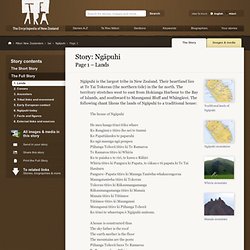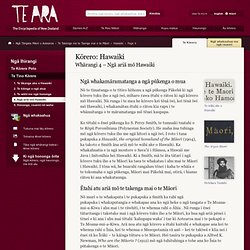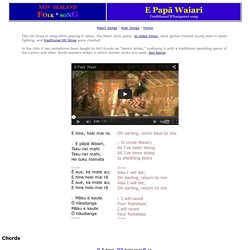

Korero Mo Hineamaru. Ngā Tāngata Māori o Aotearoa. Lands – Ngāpuhi. Ngāpuhi is the largest tribe in New Zealand.

Their heartland lies at Te Tai Tokerau (the northern tide) in the far north. The territory stretches west to east from Hokianga Harbour to the Bay of Islands, and southward to Maunganui Bluff and Whāngārei. The following chant likens the lands of Ngāpuhi to a traditional house: The house of Ngāpuhi He mea hanga tēnei tōku whare Ko Ranginui e titiro iho nei te tuanui Ko Papatūānuku te paparahi Ko ngā maunga ngā poupou Pūhanga Tohorā titiro ki Te Ramaroa Te Ramaroa titiro ki Whiria Ko te paiaka o te riri, te kawa o Rāhiri Whiria titiro ki Panguru ki Papata, te rākau e tū papata ki Te Tai Hauāuru Panguru–Papata titiro ki Maunga Taniwha-whakarongorua Maungataniwha titiro ki Tokerau Tokerau titiro ki Rākaumangamanga Rākaumangamanga titiro ki Manaia Manaia titiro ki Tūtāmoe Tūtāmoe titiro ki Maunganui Maunganui titiro ki Pūhanga Tohorā Ko tēnei te wharetapu ō Ngāpuhi-nuitonu.
Mountains How to cite this page: Rāwiri Taonui. 4. Ngā ariā mō Hawaiki – Hawaiki. Ngā whakamāramatanga a ngā pūkenga o mua Nō te tīmatanga o te titiro hōhonu a ngā pūkenga Pākehā ki ngā kōrero tuku iho a ngā iwi, mīharo rawa ētahi o rātou ki ngā kōrero mō Hawaiki.

Nā runga i te mea he kōrero kei tēnā iwi, kei tēnā iwi mō Hawaiki, i whakamātau ētahi o rātou kia rapu i te whānuitanga o te māramatanga mō tēnei kaupapa. Ko tētahi o ēnei pūkenga ko S. Percy Smith, te tumuaki tuatahi o te Rōpū Poronihiana (Polynesian Society). He maha āna tuhinga mō ngā kōrero tuku iho me ngā hītori a ngā iwi. Ētahi atu ariā mō te takenga mai o te Māori Nō muri o te whakaputa i te pukapuka a Smith ka rahi ngā pukapuka i whakaputangia e whakapae ana ko ngā heke o ngā tangata o Te Moana-nui-a-Kiwa i ahu mai i te rāwhiti, i te whenua rahi o Āhia . Ngā rangahautanga o ēnei rā He maha ngā kōrero i ēnei rā e whakahē ana i ngā tikanga a Smith.
Me pēnei te tohu i te whārangi: NZ Folk Song * E Papa (stick game) The song E Papa Waiari, and its stick game directions, can be found on pages 74-77 as "Titi-Torea" in Games for Girl Scouts, published by Girl Scouts of the USA.

But this game is sometimes wrongly called "Lemmi sticks" by USA Girl Scouts. This name is derived from the term Lummi sticks which is the name given by whites to the traditional American gambling game of Slahal played by Lummi and other Salishan tribes on the Washington-Vancouver border. In her excellent 1975 monograph, ethnomusicologist Wendy B. Stuart says gambling songs have an integral part of the Salishan tribal tradition since aboriginal times and have been maintained and preserved by oral means. Slahal, or the bone game, is of interest because of the ancient music which accompanies it. Slahal requires two pairs of cylindrical bone sections to be concealed in the hands. Large amounts of money may be bet on the outcome of the game. Wendy B.
Tai tokerau. Ta moko. Te reo.